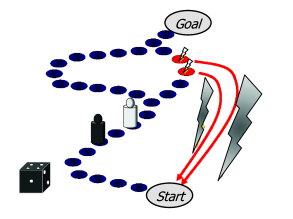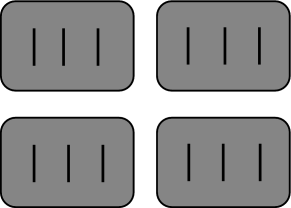Chapter 16 Competing Populations and Decision Making
We make multiple decisions in daily life. Should I cut over a busy street or take the safer pedestrian underground path which causes a 2-minute detour? Should I say ‘Hello’ to the person I see on the other side of the street or move on? Should I spend money on a simple and cheap bicycle which is less likely to be stolen, or on the faster, shiny, expensive one? Which college should I choose after high school? Should I continue after college for graduate studies and get a PhD? Some of these are small decisions of minor relevance, but there are also important decisions that can influence the course of life for several years.
Decisions are most easily analyzed in the context of games. Small children already learn in board games that they need to decide between several possibilities. A typical example is shown in Fig. 16.1A. Would you advise a child to take the safe long path to the left, or the shorter one with the risk to be reset to ‘Start’? What would you decide?

|
 |
The situation depicted in the board game presents a choice between a safe and risky option. It is typical for decision problems that are empirically studied in the field of neuroeconomics (402; 418; 189). Suppose that you have a choice between winning 100 Dollars with 100 percent probability or 200 Dollars with 50 percent probability, which option would you choose? Suppose you just received 200 dollars, but you now have the unfortunate choice between loosing half of it (100 Dollars) with 100 percent probability or even all of it (200 Dollars) with 50 percent probability, which option would you choose? If the brain activity of a human subject is imaged, while he answers these or similar monetary questions, the areas of highest activity associated with value, risk, and loss can be identified, at the coarse resolution of brain regions (402; 418).
In this chapter we work on a more microscopic level, i.e., that of neuronal activity during decision making (191). Decision making requires (i) a suitable representation of inputs and potential outcomes as well as of the values attached to the options; (ii) a selection process that picks one of the options; and (iii) potentially also some feedback that enables learning so as to achieve improved performance over several trials (418). Decision making involves different brain systems and has conscious as well as unconscious aspects (455). Here, we focus on the dynamic selection between different options in the context of perceptual decision making. There are three reasons for this focus. First, measurements of neuronal activity of single neurons or groups of neurons are available that indicate a correlation of neural activity with the choice made during a decision. Second, these experimental measurements can be linked to neuronal models of decision making. And finally, the moment of the final selection between different choices lies at the heart of decision making.
In Section 16.1, we review some of the classic recordings of neural activity during decision making in monkeys (191). In Section 16.2, a model is presented that describes the process of decision making as a competition between neuronal populations that share the same pool of inhibitory neurons (543). The mathematical analysis of the dynamics in such a model of competition is outlined in Section 16.3. Alternative descriptions of decision making are presented in Section 16.4. We close the chapter by situating models of decision making in the larger context of fundamental questions related to the notion of ‘free will’ (Section 16.5).